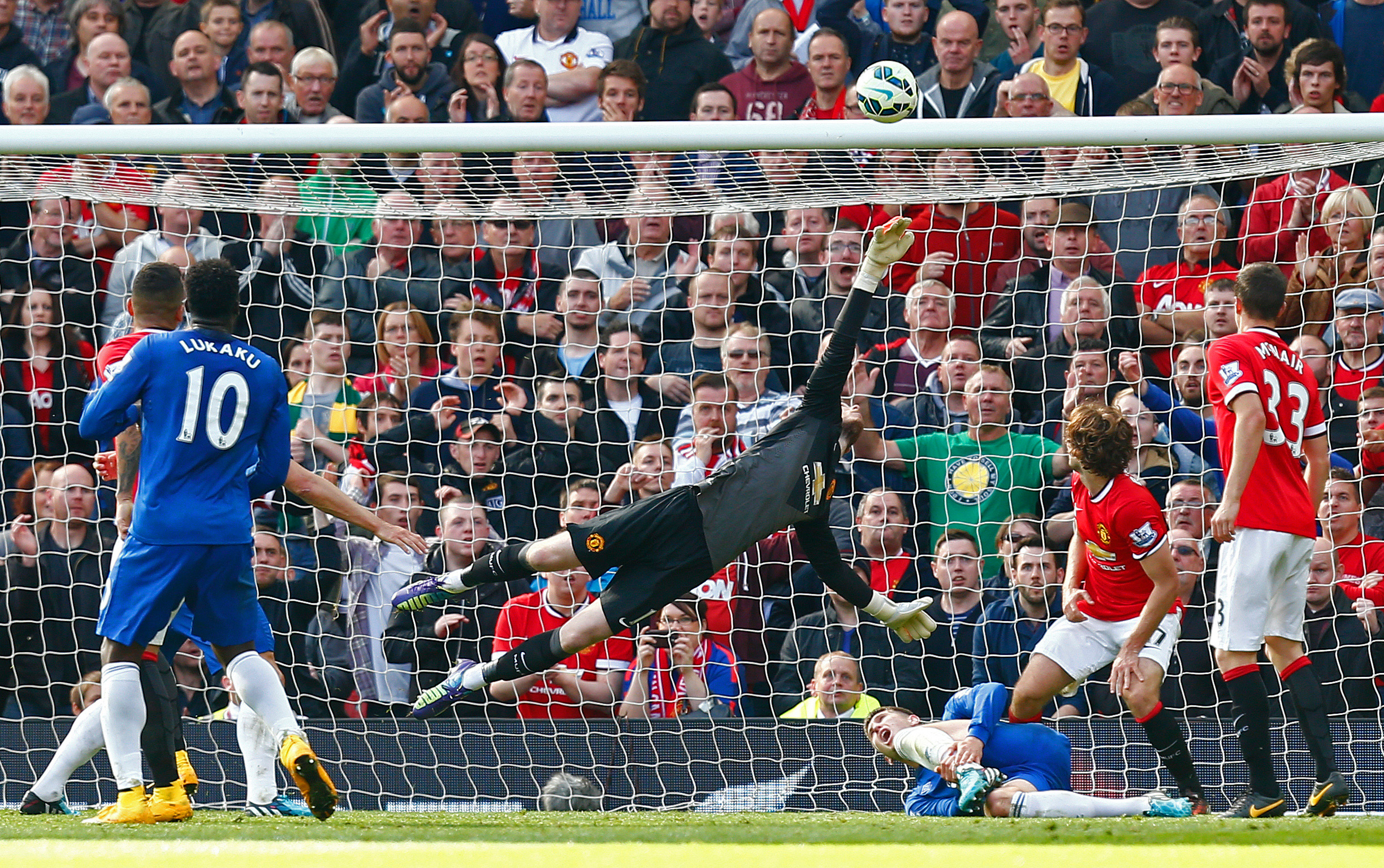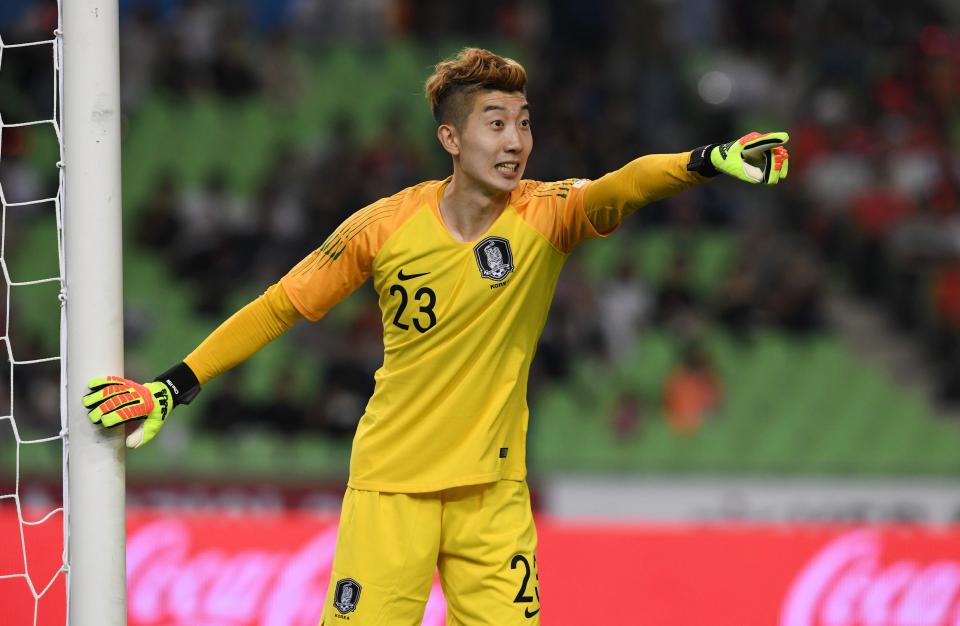For a shot heading towards the top corner, there are two main approaches for a goalkeeper to attempt the save: a top hand or bottom hand save. The terminology is fairly straightforward. Depending on which side the shot is, the top hand is on the side of the body where the shoulder is closest to the crossbar when the dive is made. If the shot is to the goalkeeper’s right, the left hand is the top hand and vice versa. The decision of hand choice only comes into play for shots in the top third of the goal. Anything lower than head-height is almost certainly the obvious, bottom hand.
Top hand save
Bottom hand save
There’s a little bit of a debate in some goalkeeping circles as to which approach is better. English goalkeeper Katie Startup wrote on the differences between the top and bottom hand saves - at eighteen years old, no less - but overall there isn't a ton of literature on the subject. Some coaches prefer the top hand acrobatics while others lean towards the simplicity of the bottom hand. Let’s break down the advantages for both types of saves.
Bottom Hand
The most obvious positive about using the bottom hand is that it is closer to whichever post the goalkeeper is diving towards. With the ease of using the nearer hand on reaction saves, it makes sense to extend their territory for shots floating to the top corner. Whether it is a strong palm or fingertip save, the natural flow to the bottom hand dive matches the simplicity of the save. Additionally, it’s easier to line up the hand-to-ball coordination the closer the hand is to the ball.
The bottom hand save has a very specific bonus factor, one that isn’t discussed much, and it's centered on the wrist. For skipping or lofted balls to the goalkeeper's side, the bottom hand save offers a flick ability unique to the hand. For American audiences, they might remember Stefan Frei’s save that kept Seattle in the 2017 MLS Final. Non-millennial soccer fans may be familiar with Gordon Banks’ immaculate stop on Pele. And of course, our most hipster of readers will be quick to recall David Seaman’s Stretch Armstrong save in the 2003 FA Cup semi-final.
You can actually see a brief moment where Frei first chooses to go with the top hand but instead opts for the bottom hand.
All three are similar in that the flexibility of the wrist helps flick the ball from the goalmouth. This is a major advantage that the bottom hand can offer that the top hand would struggle on. It's almost the equivalent of a forehand throw on a frisbee versus a big bear paw. The forehand throw contains a lot of wrist action while the swatting bear paw has some, but not nearly as much.
As for disadvantages with the bottom hand, there aren’t many poor aspects to the save, although there are areas the top hand is better at. Perhaps most notably, a top hand typically clears rebounds farther than what a bottom can offer (as shown in Seaman's save). This is why the top hand is preferred on back the bar situations as the top hand has the strength to push the ball over and past the crossbar. Additionally, using your bottom hand can be awkwardly paired with jumping off your lead foot. The iconic goal David Seaman conceded against Brazil in 2002 showcases this. Notice how the narrator heckles the poor Englishman for his lack of jumping. Had the English goalkeeper gone for a top hand save, he would have been significantly closer to the ball with an additional spring to his jump.
Top Hand
The 2018 World Cup offered us a number of memorable goalkeeping moments, including a number of stellar top hand saves. Russia' Igor Akineev made a wonderful tip over in the 90th minute against Uruguay, both Mohamed El-Shenawy and Lovre Kalinić utilized a top hand correctly, and of course, Courtois showed Neymar a massive paw in their quarterfinal matchup.
Top hand save at 0:32
Notice how far the ball is redirected off Courtois' hand, along with the other top hand saves linked above. Whether needing to tip a ball over or around the crossbar, the ability to displace a shot is a strong advantage to the top hand save. While the wrist does exhibit some movement on each save, the overall strength and leverage of the joint play a big role in making the save, along with the elbow extension and fingers flicking the ball onward.
While some are against the top hand entirely, the top hand can offer a little more reach across the goalmouth compared to the bottom hand, although it requires some time to cover the distance. If you were to stand with just your right foot on the ground, you can reach higher with your left hand by tilting your hips and shoulders than you could with your right hand. A similar process occurs when diving off the lead foot, the top hand will actually cover more distance (especially the more vertical the jump is) but will need a little more time to do so. This is why top hand saves typically occur when a goalkeeper has the time to move their feet. The graph shows below shows how, over time, the top hand (red line) can actually outcover the bottom hand (blue line).
As time passes (left to right), the top hand (red line) will eventually surpass the bottom hand (blue) in distance but is starting farther behind.
Although a top hand can be found in highlight-reel saves, it does require mastery of all the moving pieces. Precise footwork is more necessary with the top hand save. It’s not altogether rare to see a goalkeeper attempt a top hand save only to mistime their approach, leaving themselves flapping in the wind. Top hand saves can also obstruct the vision of the goalkeeper with the arm crossing in front of his or her face.
Conclusion
When deciding which hand is the correct one for a save, the main response you’ll hear can likely be boiled down to “use whatever works”. Ultimately, the choice of hand ties back into the style and personality that comes from each and every goalkeeper. Ideally, a goalkeeper has tried both types of saves and has drawn the line on where they feel comfortable with each hand. Some goalkeepers will use their writing or dominant hand for every extension save, regardless of the situation. However, this can lead to an unnecessary weakness for the goalkeeper. A goalkeeper should be efficient with both hands as they are with their feet, even if they have different preferences between themselves.
Regardless of which hand a goalkeeper chooses to us, it’s good to remember the pros and cons of each. The bottom hand can reach the ball quicker and is typically more simple to line up, although it may not offer the desired extended reach or leverage to displace to a ball. The top hand save, in contrast, will typically parry a ball with a strong force and can cover more of the goalmouth than the bottom hand, although it will need the correct time and footwork to do so.












